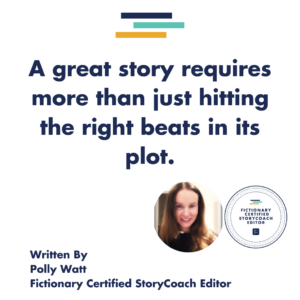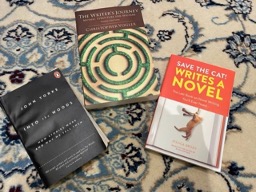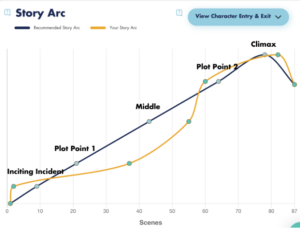
Have you ever written 60-120,000 words of a novel, only to sit back, read your manuscript and wonder how any author ever manages to write a plot that actually feels like a story?
If so, you may realise your plot isn’t quite there yet.
Maybe your draft contains all the elements you’d expect in a story: characters making difficult decisions, struggling with conflict, relationship dilemmas, moral quandaries, life-and-death experiences – but it still doesn’t feel as connected as the last bestseller or literary prize-winning novel you read.
It’s easier to understand why story structure matters once you’ve read a manuscript lacking it.
Perhaps you educated yourself on story structure before, during, or after the writing of your manuscript, and don’t understand why your story still doesn’t work, despite hitting the beats in all the correct places.
A great story requires more than just ‘hitting the right beats’ in its plot. It requires these beats connect inextricably with each other. To understand why, let’s deep dive into what these plot beats are, and then—crucially—why they matter, and how you connect them.
What are the Plot Beats?

Countless books and blog posts exist on this subject. In brief, the Story Arc’s key plot points are:
#1 The Inciting Incident
This beat is called ‘The Catalyst’ in Jessica Brody’s Save the Cat Writes a Novel, ‘The Call to Adventure’ in Christopher Vogler’s The Writer’s Journey, and ‘Awakening’ in John Yorke’s Into the Woods.
This beat can arrive anytime in the first 15 percent of the story.
Prior to the inciting Incident you have the Set-Up, or ‘Ordinary World’. Some modern stories open with the Inciting incident, with no prior Set-up.
#2 Plot Point 1
This plot beat is called ‘Break Into Two’ in Save the Cat, ‘Crossing the First Threshold’ in The Writer’s Journey, and ‘Acceptance’ in Into the Woods.
It comes at the 20-25 percent mark.
#3 The Middle/Midpoint
This is called the ‘Ordeal’ in the Writer’s Journey.
The plot beat comes at the 50 percent mark.
#4 Plot Point 2
Otherwise known as ‘The All is Lost’ in Save the Cat, ‘The Road Back’ in The Writer’s Journey, and ‘Regression’ in Into the Woods.
This plot beat comes at 75 percent.
#5 The Climax
It’s called ‘The Finale’ in Save the Cat, ‘Resurrection’ in Writer’s Journey, ‘Reawakening’ in Into the Woods.
This plot beat comes at the 80-90 percent mark.
#6 The Resolution
Also known as “The Final Image” in Save The Cat Writes a Novel.
For further details on these beats, check out Fictionary Certified StoryCoach Editor, Kara Henderson’s post here.
Why Does Plot Structure Matter?

This can all sound rather arbitrary, but we find these key Turning Points present in successful stories throughout time: from Antiquity (it was Aristotle who first coined the Three-Act Structure of Set-up, Confrontation and Resolution) through to the Medieval period (e.g., Beowulf), the Renaissance (e.g., Shakespeare’s plays), right into modern times.
Why is this?
Most stories are about change.
Multiple modern writing craft guides, including those by Lisa Cron, Jessica Brody, Will Storr and John Yorke, amongst others, confirm the presence of change as a central feature in almost all stories.
Whether or not the protagonist succeeds in achieving positive change throughout their story, the question, ‘Will they change?’ remains key in the reader’s mind.
The key plot points of story structure help us comprehend the process of change.
As anyone with debating experience knows: an argument should set out a proposition, show the counter-argument, and close with weighing up one side over the other. It’s the simplest, most effective way to present a case.
The three-act story structure follows this rhetorical architecture:
- Act One (0-25 %) shows the status quo of the protagonist’s life, and how this status quo disintegrates.
- Act Two (25-75 %) shows the conflict which acts as an agent of change, with the midpoint showing the protagonist’s shift from reactive to proactive.
- Act Three (75-100 %) shows how successfully the protagonist deals with the requirement to change.
However, don’t take what’s written above too literally.
DON’T make your Act 1 a conflict-free zone. In Act 1, conflict should exist, revealing why your protagonist needs to take action—either to change themselves and/or change their world.
You must have conflict and/or tension in every scene, from the opening to the end.
DON’T make your protagonist completely reactive all the way to your story’s fifty percent mark. The midpoint shift in perspective shouldn’t be from a wholly reactive protagonist to a to a wholly proactive protagonist.
The protagonist should start actively chasing their story goal from Plot Point 1 at the latest.
The midpoint shift is the pivot-point of internal change: where your protagonist looks inward, and realises how they need to change themselves (i.e., starts proactively chasing their inner goal) to achieve their story goal.
Your protagonist must be proactively chasing goals from the start.
Conflict, tension and goals are important devices for connecting your scenes and forging them into a story.
To achieve this, you must ensure all your plot point scenes, all your scene goals, and all of the conflict and tension within each and every scene all connect clearly with your story blurb, which establishes:
- Your protagonist,
- Their story goal, and;
- The stakes of failure.
For more on what a blurb is, how to write one, and how you use it to edit your novel, see here.
Here’s how Fictionary can help
Fictionary helps you “see” your Story Arc, check you’ve got the beats in the right places, and catch any parts where your plot is flat-lining (and boring your reader) or rushing (and leaving your reader saying, “What? How’d that happen so fast?”).

But what if you’ve marked out all your key beats on the Story Arc, obtained the perfect line, but still aren’t hooking readers?
Perhaps your plot points aren’t doing their job yet—or perhaps, the intervening scenes are letting the plot points down. If so, here’s where Fictionary gives you another step up.
Fictionary provides a framework for individual scene structure which reminds you to look at each and every story element in every scene, to check that no scene is letting the side down.
Because your individual scenes also need:
- Entry and exit hooks,
- Goals,
- Midpoints,
- Climaxes,
- Conflict,
- Tension,
- Connection to the story goal,
- Emotional impact on characters,
- Immersive settings, and;
- And so much more…
And how does any writer get their head around all this without forgetting something? Software specifically designed to help you check you’ve every essential story element where you need it to be can make your task more manageable.

This isn’t about “story formula”.
Characters, goals, conflict and story worlds are too complex for formulae.
This is about ensuring you’ve added the most essential story ingredients to your mix. How you arrange them, creating your own artistic vision, is entirely up to you. But try to draft scenes without all these essential elements, and chances are you’ll struggle to hook readers.
To see how the plot beats work in The Hunger Games, see here; for more advice on writing stories within Fictionary StoryTeller, here.
In conclusion
Story structure exists to help us understand ourselves, our world, and how to affect change. When writers ignore story or scene structure, readers may feel:
- Unsatisfied
- Disconnected
- Confused
- Bored
Readers may not know the story arc intellectually, but they know it instinctively, through repeated exposure to fantastic plots in literature, cinema, and television. Increase your prospects of publishing success by writing for these sophisticated readers.
Article Written by Polly Watt

A former refugee lawyer in the UK, Polly Watt honed her skills working on cases where careful editing often really was a matter of life and death.
As a Fictionary StoryCoach Editor, she will apply the same care and attention to detail to your structural story edit. She’s passionate about stories and loves working on all different types of literary genres.
Speaking of Jessica Brody…

Want to attend a FREE 45 minute Q&A with Jessica?
Join the Fictionary community for free, HERE, and reserve your spot now.
Jessica is speaking to community members on Thursday June 08, 2023 at 3PM (ET).


